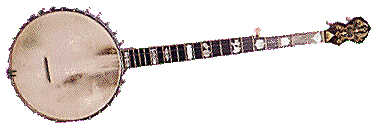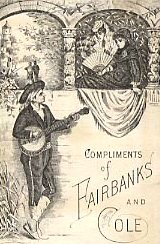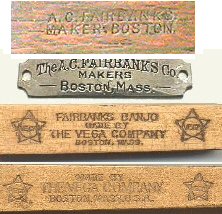

For an in depth discussion about important dating information visit the Fairbanks Research article.
 The A.C. Fairbanks Company (incorporated 1875) was succeeded in 1903 by the Vega Company (established 1889). Vega continued to mark their banjos "A.C. Fairbanks" until the middle teens.
The A.C. Fairbanks Company (incorporated 1875) was succeeded in 1903 by the Vega Company (established 1889). Vega continued to mark their banjos "A.C. Fairbanks" until the middle teens.
During 1880-1890 Fairbanks joined with William A. Cole, a successful performer and teacher, and produced approximately 9000 banjos as Fairbanks & Cole. They split in 1890 and
 Fairbanks restarted the numbering at about 1, as did W.A. Cole. From 1890 to 1914 Fairbanks (later Vega) made Fred Bacon banjos. Between 1903 and 1914 Vega made some S.S. Stewart banjos. The years matched to the serial numbers are an educated approximation; they are accurate within a year or two, and even the dates of introduction of major improvements are based on ads, catalogs, and contemporary news releases.
Fairbanks restarted the numbering at about 1, as did W.A. Cole. From 1890 to 1914 Fairbanks (later Vega) made Fred Bacon banjos. Between 1903 and 1914 Vega made some S.S. Stewart banjos. The years matched to the serial numbers are an educated approximation; they are accurate within a year or two, and even the dates of introduction of major improvements are based on ads, catalogs, and contemporary news releases.
In the 1960s, urban renewal in Boston forced Vega to move from the Columbus Avenue location where they had been from 1917 to c1961, to Leon Street in Boston, where they stayed until 1966. They moved to Needham Heights, where the owners were closer to home. They weren't there for long before selling to Martin.
Vega continued in business in the Nelson Family until March 15, 1970 when the name, equipment, and all the rights were sold to C.F. Martin, a respected guitar manufacturer, in Nazareth, PA. Martin made some banjos, and marketed import instruments, under the Vega brand name until March, 1979 when they sold the Vega rights to the Galaxy Trading Company, an Asian conglomerate. All Vegas from the Galaxy period are imported. In the mid-1980s, The Deering Banjo Company purchased the Vega name and rights from Galaxy and brought this venerable banjo name back to the US and their Spring Valley, CA factory.
For a listing of instrument models and a discussion of some of Fairbanks' and Vega's products, visit the FAQ (Frequently Asked Questions) article and the web sites listed at the end of this article.
To use the chart below, find the serial number closest to yours and interpolate between the listed numbers to get a best approximation.
| YEAR | LAST NO. | YEAR | LAST NO. | YEAR | LAST NO. |
| 1875 | Earliest #243 | 1875 | 300 | 1880 | 980 |
| 1885 | 5600 | 1890 | (Electric #65) | 1891 | 1400 |
| 1895 | 14900 | 1896 | (Metal nameplate) | 19001 | 19000 |
| 1901 | (Whyte Laydie #20343) | 1904 | (Fire #23070) | 1905 | 23500 |
| 1909 | (Tubaphone #25052) | 1910 | (F-V stamp) | 1910 | 27000 |
| 1915 | 32200 | 1920 | 40000 | 1922-3 | (Vega stamp c.53000) |
| 1925 | 67500 | 1930 | 95000 | 1935 | 98224 |
| 1940 | 98429 | 1945 | 98604 | 1950 | 98779 |
| 1953 | 98989 | 1954 | 99067 | 1955 | 99212 |
| 1956 | 99427 | 1957 | 99581 | 1958 | 99716 |
| 1959 | 100021 | 1960 | 100559 | 1961 | 101998 |
| 19621 | start# 10300 | 1962 | last#.10522 | 1963 | 12130 |
| 1964 | 12564 | 19642 | 124001 | 1964 | 125641 |
| 1965 | 126771 | 1966 | 127681 | 1967 | 128564 |
| 1968 | 129119 | 1969 | 129682 | 05/15/70 | Sold to CFM |
| 1970 | 130048 | 1971 | 139400 | 1972 | New series starting M1 |
| 03/79 | Sold to Galaxy | c1985 | Sold to Deering | ||
|
1. Due to a printers' error, serial numbers with only 5 digits and on yellow labels were used from 10/1962 (no. A-10300) to 2/1964 (A-12400). The "A" stands for "Ajustable truss rod." 2. A new series of numbers was started in February, 1964. | |||||
Q: What years was the flower pot headstock inlay available on the Tubaphone style 3, 5 string banjo? DL
A: Roughly 1909 to 1913, the last serial number seen was 30441.
Q: When did Vega (Fairbanks plate models) switch the Whyte Laydie models from a grooved/slotted stretcher band to a notched one? Fairbanks plate to F-V stamp to Vega stamp? Ferrule? Hooks? Rims? Fingerboards?
A: Although there are no absolutes where Vega is concerned, several years of research have led me to these conclusions about when certain changes were made (see Fairbanks Research article for data):
Q: Did Vega make any banjos before buying out Fairbanks? BR
A: There are a very few Fairbanks made banjos (several of them Regents) with pre-fire serial numbers circa 22900, stamped simply "Vega" in an oval border. There is no evidence that Vega actually made banjos prior to buying out Fairbanks.
Q: At what point did Vega go from ball end to open end bracket nuts? JC
A: The earliest one I have recorded with open end nuts is #87058.
Q: At what point did Vega go to "through the rim" bracket bolts on its WL and TPH banjos?
A: Serial #91892 is the earliest collected banjo with the bolts through the rim. It seems to coincide roughly with the introduction of the Vox models, the earliest serial number of which I have recorded is 93828.
Q: Which flanges came first on Vega banjos, was it the 4 piece or the 28 piece? I was under the impression it was the 28 piece but according to the Tsumura red book it was the 4 piece. KS
A: There are several errors in the otherwise excellent Tsumura Red Book. Vega offered banjos in many sizes, so it stands to reason the 28 flanges would predate the 4 pieces, since they could go on a greater variety of sizes. The patent for the individual flange plates was filed 10/30/1923 and issued to Carl Nelson 08/11/1925. The patent for the 4 piece Vega Vox flange, with its trapezoidal shaped soundholes, was filed 03/21/1927 and issued to William Nelson on 03/12/1929. The Nelsons were the owners of, and assigned their patents to, Vega. According to banjo historian Stu Cohen, checking the relevant catalogs, "The Vegaphone (a Tubaphone model with the 28 piece flange and resonator) was introduced in August, 1923. The 4 piece flange was introduced in August, 1928, along with the Vega Vox and the addition of Pearloid on the resonator wall." Information added by Stan Werbin, "the individual flanges continued on several models (including sometimes on the Vegaphone Professional), gradually appearing only on lesser models, until they disappeared for good sometime in 1932."
Much of the information included in this article is the result of my own research, and therefore any errors are mine to claim. However, I am grateful for having received (and continue to receive) help and support from Jim Bollman, Stu Cohen, George Gruhn and Stan Werbin plus too many readers to mention all of them here, but all of whom have contributed information that either added to or confirmed what we now know. The serial numbers and dates are, however, at best approximate. MIH

| 
|